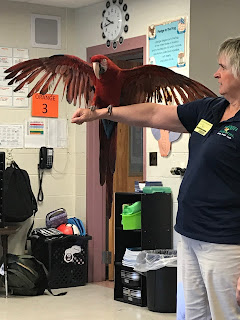Last Wednesday, the entire second grade was treated to an encore presentation from Wildlife Encounters. Again, this wonderful organization brought several animals to SMS, this time with a focus on how animals contribute to the plants of our ecosystem (Jean quickly told us that although we were studying plants, they didn't bring plants to show us---after all, it's not Plant Encounters!)
The first animal Jean introduced us to was the MILLIPEDE. This animal is not an insect (it has too many legs!), but rather an arthropod. Millipedes live above the soil in a layer of leaves feasting on "dead stuff", just like worms do. They create a fertilizer that makes the soil extra nutritious to help feed plant species. This particular millipede is found in the Southwest of the United States, but we learned that millipedes are found in our backyard as well---only much, much smaller (as opposed to the nearly foot long millipedes found in Africa!). The most interesting thing we learned, however? Milli means thousand and pede means foot, and interestingly enough, millipedes don't quite have 1,000 legs! We all agreed, however, they sure do have close enough!
 |
| "Leaf Litter" = the home of the millipede! |
Next, Jean brought out Noah, the GREEN-WINGED MACAW. Noah is a seed disperser. He eats seeds, flies away, and then poops the seed out in a new location. While he is a great disperser, macaws are also seed predators. His strong beak functions as a built in nutcracker! He can grind up thick shells such as walnuts and fully digest the seed (which cannot then be replanted when it comes out the other end). Noah comes from South America and lives in a flock to provide camouflage in the rain forest.
 |
| Noah looks like a Scarlet Macaw, but the green stripe on his back is what makes him different (scarlet macaws have a yellow stripe on their back). |
After his noisy entrance, Jean introduced us to Radar, the FENNEC FOX! Hailing from Africa, Radar is responsible for eating small animals that would otherwise be eating plants (animals such as lizards, mice, and insects). Those beautiful humongous ears he sports (which are the largest ears per body size of any animal), serve two functions: 1) hearing and 2) to help him cool off. We were shocked to learn that his amazing ears allowed him to hear each of our hearts beating! Pretty cool!
Another animal that has helped save plants is the CANE TOAD. The Cane Toad eats the beetles that destroy sugar cane. Unfortunately, the Cane Toad is also poisonous, so while they've helped save the sugar cane, they have also hurt the population of some animals. Native to South America, the Cane Toad was brought to Australia to help control the beetles. Once there, these toads quickly killed several species of animals there. The local animals didn't know that the toad was poisonous (like South American animals knew), would eat the toads, and then die. The Cane Toad is now known as an invasive species.
Next, we were introduced to the animal that "does it all". Fauna, the BROWN SKUNK, helps deposit rich nutrients into the soil, disperses seeds, and eats animals that eat plants! Skunks, in Jean's eyes, are one of the least respected animals, especially considering how much they help our ecosystem!! A lot of second graders had questions about the skunk's stinky spray. They were happy to learn that it actually requires a lot of energy (and is even a bit painful) for the skunk to spray, so skunks will only spray as a last resort. If you encounter a skunk in the wild, it will give you three warning signs before it actually sprays:
1. Stomps its feet in a loud and powerful way (their way of saying, "Go away!)
2. Waves its tail, aka its "stop sign" (their way of saying, "I'm scared!)
3. Turn its behind to face you; shows all of its colors in its high tail (their way of saying, "You are WAY to close, I'm about to spray!")
While only about 50% of skunks are mature enough to actually spray, 100% of skunks will act like they can!
The last animal Jean brought out was a RED TAILED BOA CONSTRICTOR. This type of constrictor dwells in the trees of South America. Jean taught us that snakes have a very small brain. That means they act only out of instinct (they'd have to with only a 7 minute memory!). While snakes are not mean, you should always act as if they're dangerous. She warned us to never put a snake around our neck. I think we can all agree to listen to that warning!
After the presentation was complete and we had met all of Jean's animal friends, we were allowed to use a "two-finger touch" to pet the boa constrictor! So fun!
Thank you again to Wildlife Encounters for sharing your wonderful creatures and enhancing our science unit!























No comments:
Post a Comment